Importance of Financial Management: Significance, Statements, Ratios, and Recommendations
VerifiedAdded on 2023/06/14
|11
|2540
|137
AI Summary
This article explains the concept and significance of financial management, financial statements, and the use of ratios in financial management. It also provides recommendations on the current performance of the organization.
Contribute Materials
Your contribution can guide someone’s learning journey. Share your
documents today.

Importance of
Financial
Management
Financial
Management
Secure Best Marks with AI Grader
Need help grading? Try our AI Grader for instant feedback on your assignments.
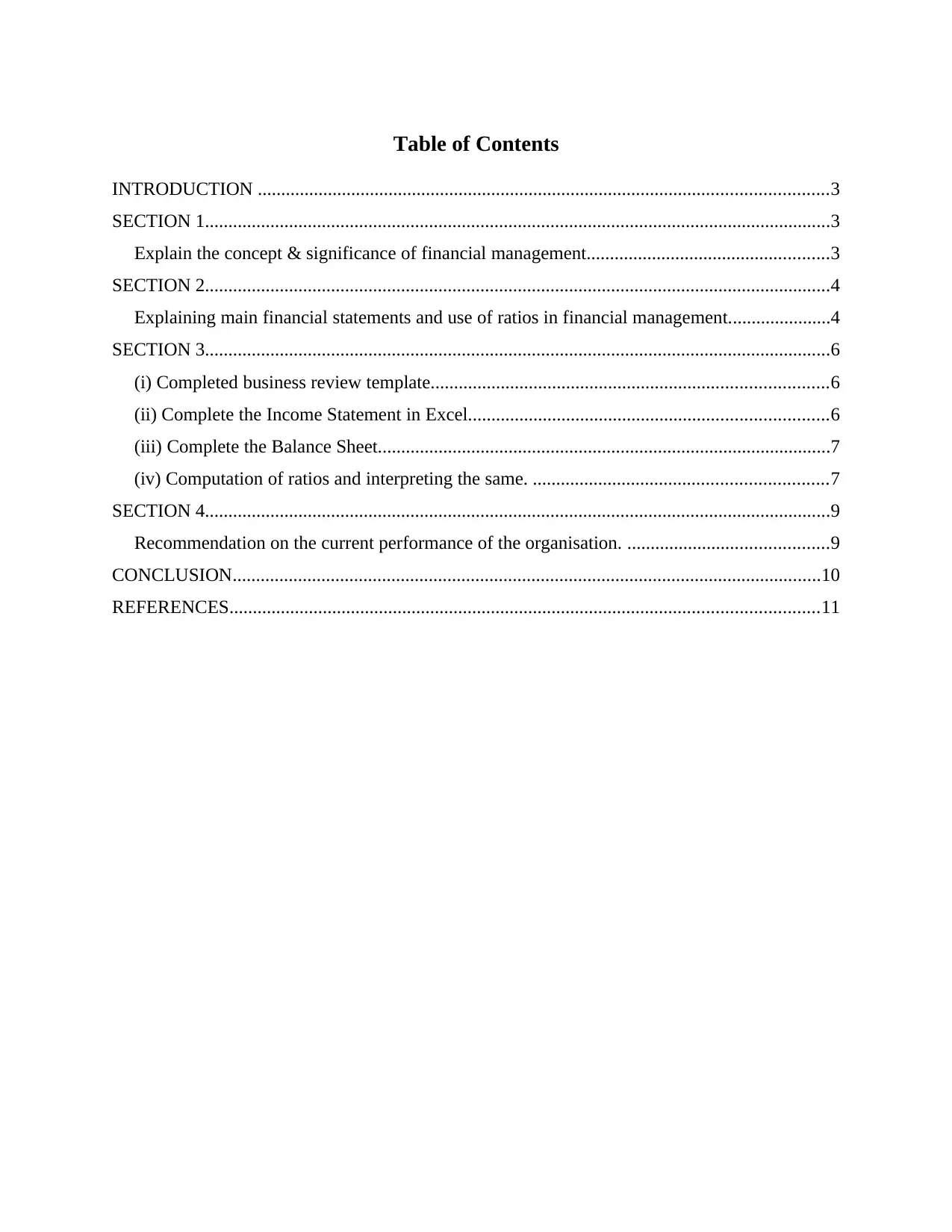
Table of Contents
INTRODUCTION ..........................................................................................................................3
SECTION 1......................................................................................................................................3
Explain the concept & significance of financial management....................................................3
SECTION 2......................................................................................................................................4
Explaining main financial statements and use of ratios in financial management......................4
SECTION 3......................................................................................................................................6
(i) Completed business review template.....................................................................................6
(ii) Complete the Income Statement in Excel.............................................................................6
(iii) Complete the Balance Sheet.................................................................................................7
(iv) Computation of ratios and interpreting the same. ...............................................................7
SECTION 4......................................................................................................................................9
Recommendation on the current performance of the organisation. ...........................................9
CONCLUSION..............................................................................................................................10
REFERENCES..............................................................................................................................11
INTRODUCTION ..........................................................................................................................3
SECTION 1......................................................................................................................................3
Explain the concept & significance of financial management....................................................3
SECTION 2......................................................................................................................................4
Explaining main financial statements and use of ratios in financial management......................4
SECTION 3......................................................................................................................................6
(i) Completed business review template.....................................................................................6
(ii) Complete the Income Statement in Excel.............................................................................6
(iii) Complete the Balance Sheet.................................................................................................7
(iv) Computation of ratios and interpreting the same. ...............................................................7
SECTION 4......................................................................................................................................9
Recommendation on the current performance of the organisation. ...........................................9
CONCLUSION..............................................................................................................................10
REFERENCES..............................................................................................................................11
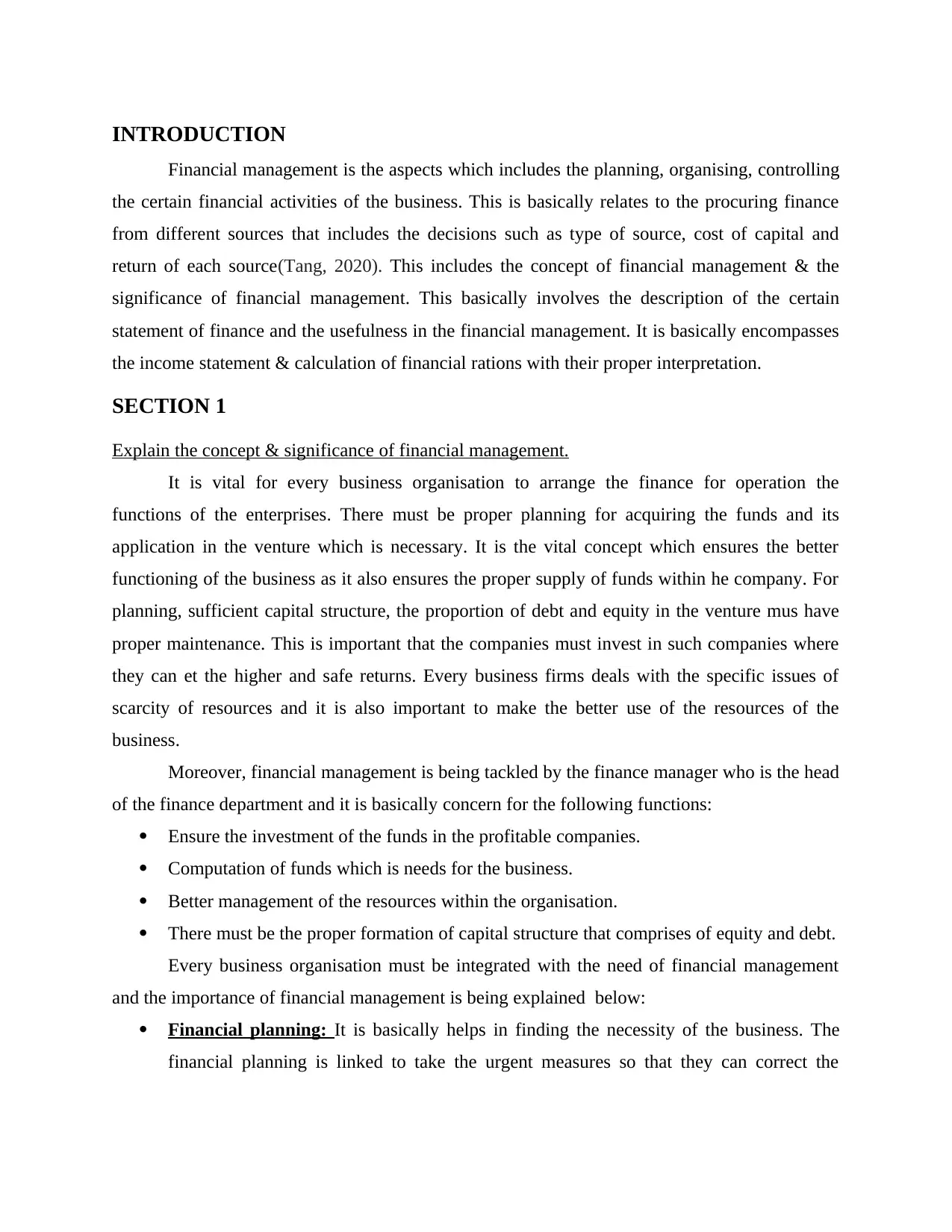
INTRODUCTION
Financial management is the aspects which includes the planning, organising, controlling
the certain financial activities of the business. This is basically relates to the procuring finance
from different sources that includes the decisions such as type of source, cost of capital and
return of each source(Tang, 2020). This includes the concept of financial management & the
significance of financial management. This basically involves the description of the certain
statement of finance and the usefulness in the financial management. It is basically encompasses
the income statement & calculation of financial rations with their proper interpretation.
SECTION 1
Explain the concept & significance of financial management.
It is vital for every business organisation to arrange the finance for operation the
functions of the enterprises. There must be proper planning for acquiring the funds and its
application in the venture which is necessary. It is the vital concept which ensures the better
functioning of the business as it also ensures the proper supply of funds within he company. For
planning, sufficient capital structure, the proportion of debt and equity in the venture mus have
proper maintenance. This is important that the companies must invest in such companies where
they can et the higher and safe returns. Every business firms deals with the specific issues of
scarcity of resources and it is also important to make the better use of the resources of the
business.
Moreover, financial management is being tackled by the finance manager who is the head
of the finance department and it is basically concern for the following functions:
Ensure the investment of the funds in the profitable companies.
Computation of funds which is needs for the business.
Better management of the resources within the organisation.
There must be the proper formation of capital structure that comprises of equity and debt.
Every business organisation must be integrated with the need of financial management
and the importance of financial management is being explained below:
Financial planning: It is basically helps in finding the necessity of the business. The
financial planning is linked to take the urgent measures so that they can correct the
Financial management is the aspects which includes the planning, organising, controlling
the certain financial activities of the business. This is basically relates to the procuring finance
from different sources that includes the decisions such as type of source, cost of capital and
return of each source(Tang, 2020). This includes the concept of financial management & the
significance of financial management. This basically involves the description of the certain
statement of finance and the usefulness in the financial management. It is basically encompasses
the income statement & calculation of financial rations with their proper interpretation.
SECTION 1
Explain the concept & significance of financial management.
It is vital for every business organisation to arrange the finance for operation the
functions of the enterprises. There must be proper planning for acquiring the funds and its
application in the venture which is necessary. It is the vital concept which ensures the better
functioning of the business as it also ensures the proper supply of funds within he company. For
planning, sufficient capital structure, the proportion of debt and equity in the venture mus have
proper maintenance. This is important that the companies must invest in such companies where
they can et the higher and safe returns. Every business firms deals with the specific issues of
scarcity of resources and it is also important to make the better use of the resources of the
business.
Moreover, financial management is being tackled by the finance manager who is the head
of the finance department and it is basically concern for the following functions:
Ensure the investment of the funds in the profitable companies.
Computation of funds which is needs for the business.
Better management of the resources within the organisation.
There must be the proper formation of capital structure that comprises of equity and debt.
Every business organisation must be integrated with the need of financial management
and the importance of financial management is being explained below:
Financial planning: It is basically helps in finding the necessity of the business. The
financial planning is linked to take the urgent measures so that they can correct the
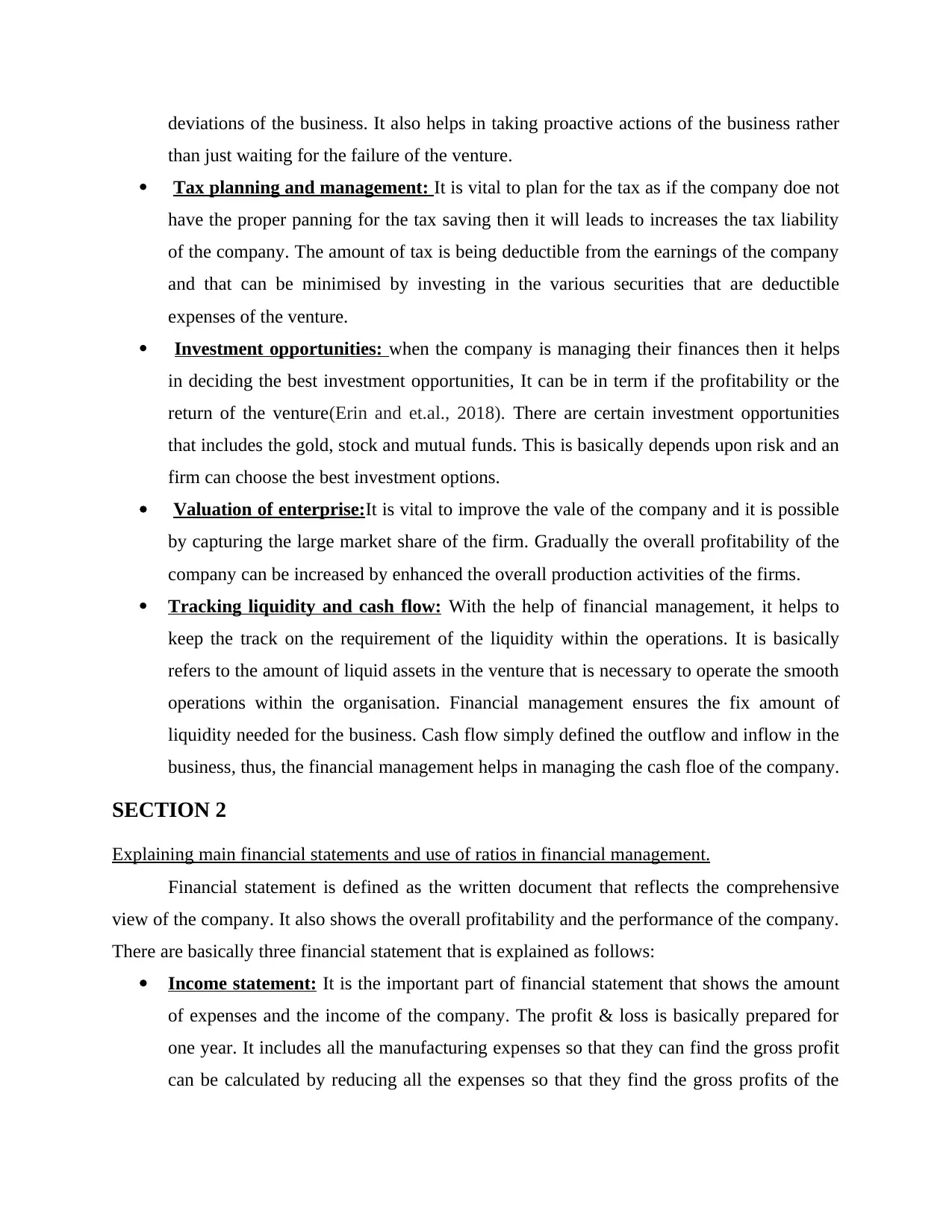
deviations of the business. It also helps in taking proactive actions of the business rather
than just waiting for the failure of the venture.
Tax planning and management: It is vital to plan for the tax as if the company doe not
have the proper panning for the tax saving then it will leads to increases the tax liability
of the company. The amount of tax is being deductible from the earnings of the company
and that can be minimised by investing in the various securities that are deductible
expenses of the venture.
Investment opportunities: when the company is managing their finances then it helps
in deciding the best investment opportunities, It can be in term if the profitability or the
return of the venture(Erin and et.al., 2018). There are certain investment opportunities
that includes the gold, stock and mutual funds. This is basically depends upon risk and an
firm can choose the best investment options.
Valuation of enterprise:It is vital to improve the vale of the company and it is possible
by capturing the large market share of the firm. Gradually the overall profitability of the
company can be increased by enhanced the overall production activities of the firms.
Tracking liquidity and cash flow: With the help of financial management, it helps to
keep the track on the requirement of the liquidity within the operations. It is basically
refers to the amount of liquid assets in the venture that is necessary to operate the smooth
operations within the organisation. Financial management ensures the fix amount of
liquidity needed for the business. Cash flow simply defined the outflow and inflow in the
business, thus, the financial management helps in managing the cash floe of the company.
SECTION 2
Explaining main financial statements and use of ratios in financial management.
Financial statement is defined as the written document that reflects the comprehensive
view of the company. It also shows the overall profitability and the performance of the company.
There are basically three financial statement that is explained as follows:
Income statement: It is the important part of financial statement that shows the amount
of expenses and the income of the company. The profit & loss is basically prepared for
one year. It includes all the manufacturing expenses so that they can find the gross profit
can be calculated by reducing all the expenses so that they find the gross profits of the
than just waiting for the failure of the venture.
Tax planning and management: It is vital to plan for the tax as if the company doe not
have the proper panning for the tax saving then it will leads to increases the tax liability
of the company. The amount of tax is being deductible from the earnings of the company
and that can be minimised by investing in the various securities that are deductible
expenses of the venture.
Investment opportunities: when the company is managing their finances then it helps
in deciding the best investment opportunities, It can be in term if the profitability or the
return of the venture(Erin and et.al., 2018). There are certain investment opportunities
that includes the gold, stock and mutual funds. This is basically depends upon risk and an
firm can choose the best investment options.
Valuation of enterprise:It is vital to improve the vale of the company and it is possible
by capturing the large market share of the firm. Gradually the overall profitability of the
company can be increased by enhanced the overall production activities of the firms.
Tracking liquidity and cash flow: With the help of financial management, it helps to
keep the track on the requirement of the liquidity within the operations. It is basically
refers to the amount of liquid assets in the venture that is necessary to operate the smooth
operations within the organisation. Financial management ensures the fix amount of
liquidity needed for the business. Cash flow simply defined the outflow and inflow in the
business, thus, the financial management helps in managing the cash floe of the company.
SECTION 2
Explaining main financial statements and use of ratios in financial management.
Financial statement is defined as the written document that reflects the comprehensive
view of the company. It also shows the overall profitability and the performance of the company.
There are basically three financial statement that is explained as follows:
Income statement: It is the important part of financial statement that shows the amount
of expenses and the income of the company. The profit & loss is basically prepared for
one year. It includes all the manufacturing expenses so that they can find the gross profit
can be calculated by reducing all the expenses so that they find the gross profits of the
Secure Best Marks with AI Grader
Need help grading? Try our AI Grader for instant feedback on your assignments.
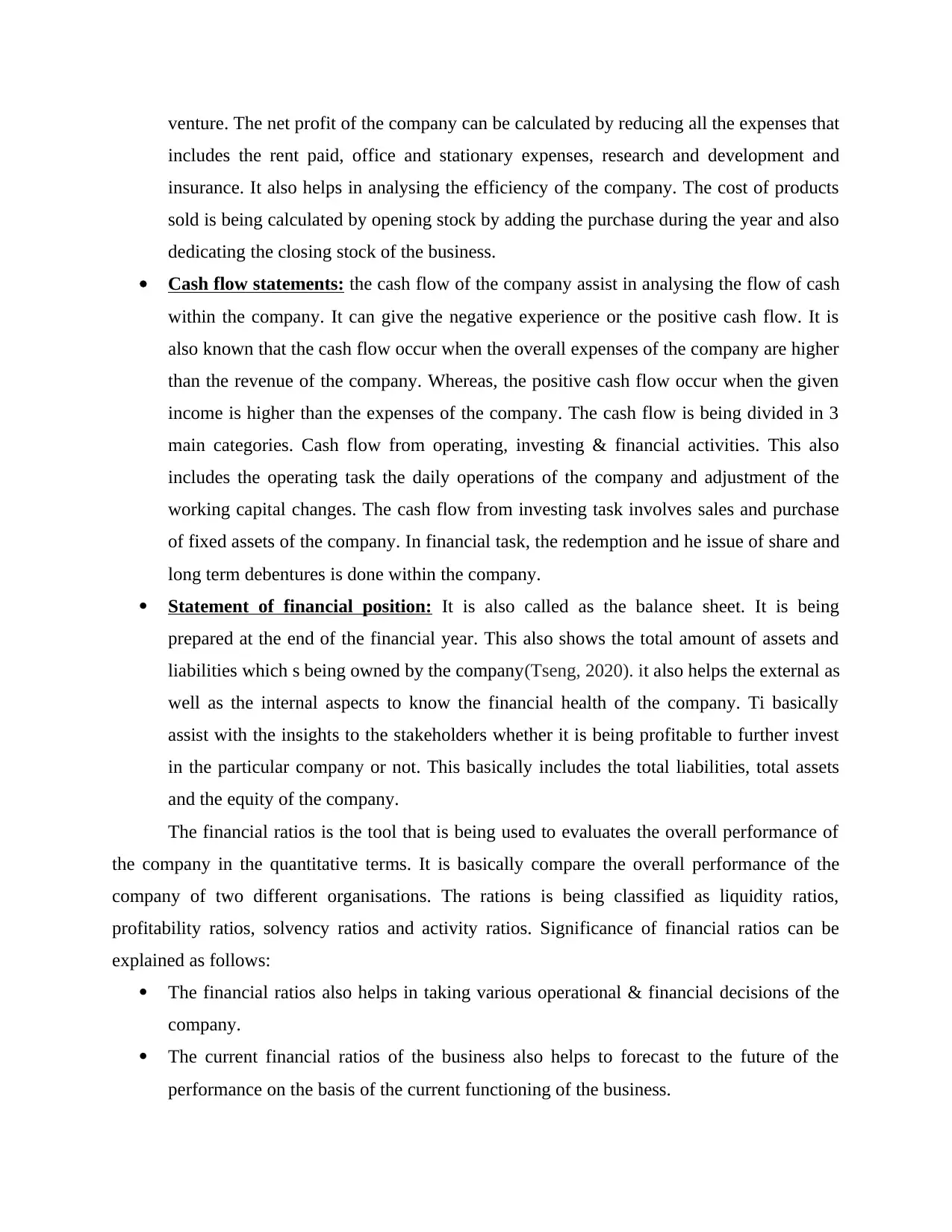
venture. The net profit of the company can be calculated by reducing all the expenses that
includes the rent paid, office and stationary expenses, research and development and
insurance. It also helps in analysing the efficiency of the company. The cost of products
sold is being calculated by opening stock by adding the purchase during the year and also
dedicating the closing stock of the business.
Cash flow statements: the cash flow of the company assist in analysing the flow of cash
within the company. It can give the negative experience or the positive cash flow. It is
also known that the cash flow occur when the overall expenses of the company are higher
than the revenue of the company. Whereas, the positive cash flow occur when the given
income is higher than the expenses of the company. The cash flow is being divided in 3
main categories. Cash flow from operating, investing & financial activities. This also
includes the operating task the daily operations of the company and adjustment of the
working capital changes. The cash flow from investing task involves sales and purchase
of fixed assets of the company. In financial task, the redemption and he issue of share and
long term debentures is done within the company.
Statement of financial position: It is also called as the balance sheet. It is being
prepared at the end of the financial year. This also shows the total amount of assets and
liabilities which s being owned by the company(Tseng, 2020). it also helps the external as
well as the internal aspects to know the financial health of the company. Ti basically
assist with the insights to the stakeholders whether it is being profitable to further invest
in the particular company or not. This basically includes the total liabilities, total assets
and the equity of the company.
The financial ratios is the tool that is being used to evaluates the overall performance of
the company in the quantitative terms. It is basically compare the overall performance of the
company of two different organisations. The rations is being classified as liquidity ratios,
profitability ratios, solvency ratios and activity ratios. Significance of financial ratios can be
explained as follows:
The financial ratios also helps in taking various operational & financial decisions of the
company.
The current financial ratios of the business also helps to forecast to the future of the
performance on the basis of the current functioning of the business.
includes the rent paid, office and stationary expenses, research and development and
insurance. It also helps in analysing the efficiency of the company. The cost of products
sold is being calculated by opening stock by adding the purchase during the year and also
dedicating the closing stock of the business.
Cash flow statements: the cash flow of the company assist in analysing the flow of cash
within the company. It can give the negative experience or the positive cash flow. It is
also known that the cash flow occur when the overall expenses of the company are higher
than the revenue of the company. Whereas, the positive cash flow occur when the given
income is higher than the expenses of the company. The cash flow is being divided in 3
main categories. Cash flow from operating, investing & financial activities. This also
includes the operating task the daily operations of the company and adjustment of the
working capital changes. The cash flow from investing task involves sales and purchase
of fixed assets of the company. In financial task, the redemption and he issue of share and
long term debentures is done within the company.
Statement of financial position: It is also called as the balance sheet. It is being
prepared at the end of the financial year. This also shows the total amount of assets and
liabilities which s being owned by the company(Tseng, 2020). it also helps the external as
well as the internal aspects to know the financial health of the company. Ti basically
assist with the insights to the stakeholders whether it is being profitable to further invest
in the particular company or not. This basically includes the total liabilities, total assets
and the equity of the company.
The financial ratios is the tool that is being used to evaluates the overall performance of
the company in the quantitative terms. It is basically compare the overall performance of the
company of two different organisations. The rations is being classified as liquidity ratios,
profitability ratios, solvency ratios and activity ratios. Significance of financial ratios can be
explained as follows:
The financial ratios also helps in taking various operational & financial decisions of the
company.
The current financial ratios of the business also helps to forecast to the future of the
performance on the basis of the current functioning of the business.
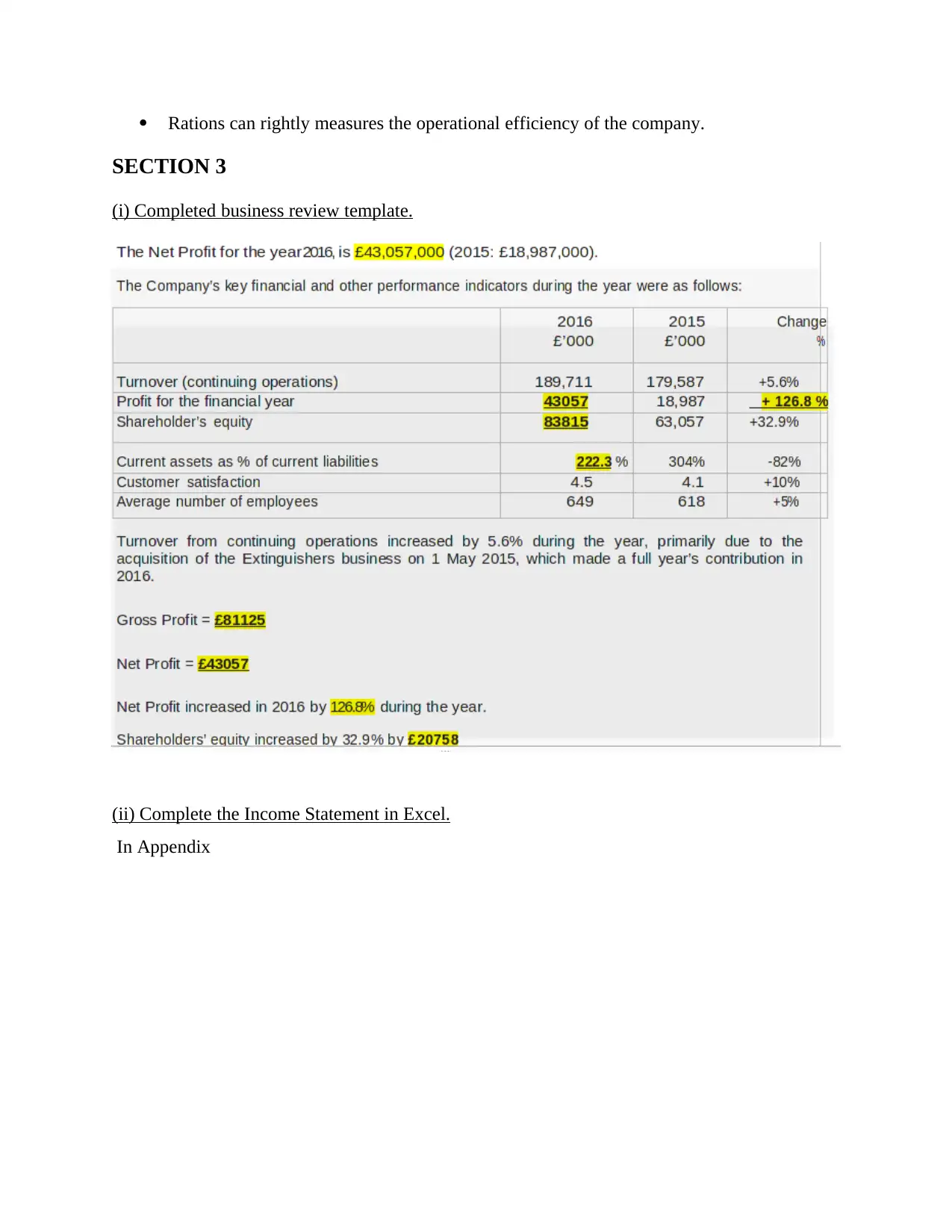
Rations can rightly measures the operational efficiency of the company.
SECTION 3
(i) Completed business review template.
(ii) Complete the Income Statement in Excel.
In Appendix
SECTION 3
(i) Completed business review template.
(ii) Complete the Income Statement in Excel.
In Appendix
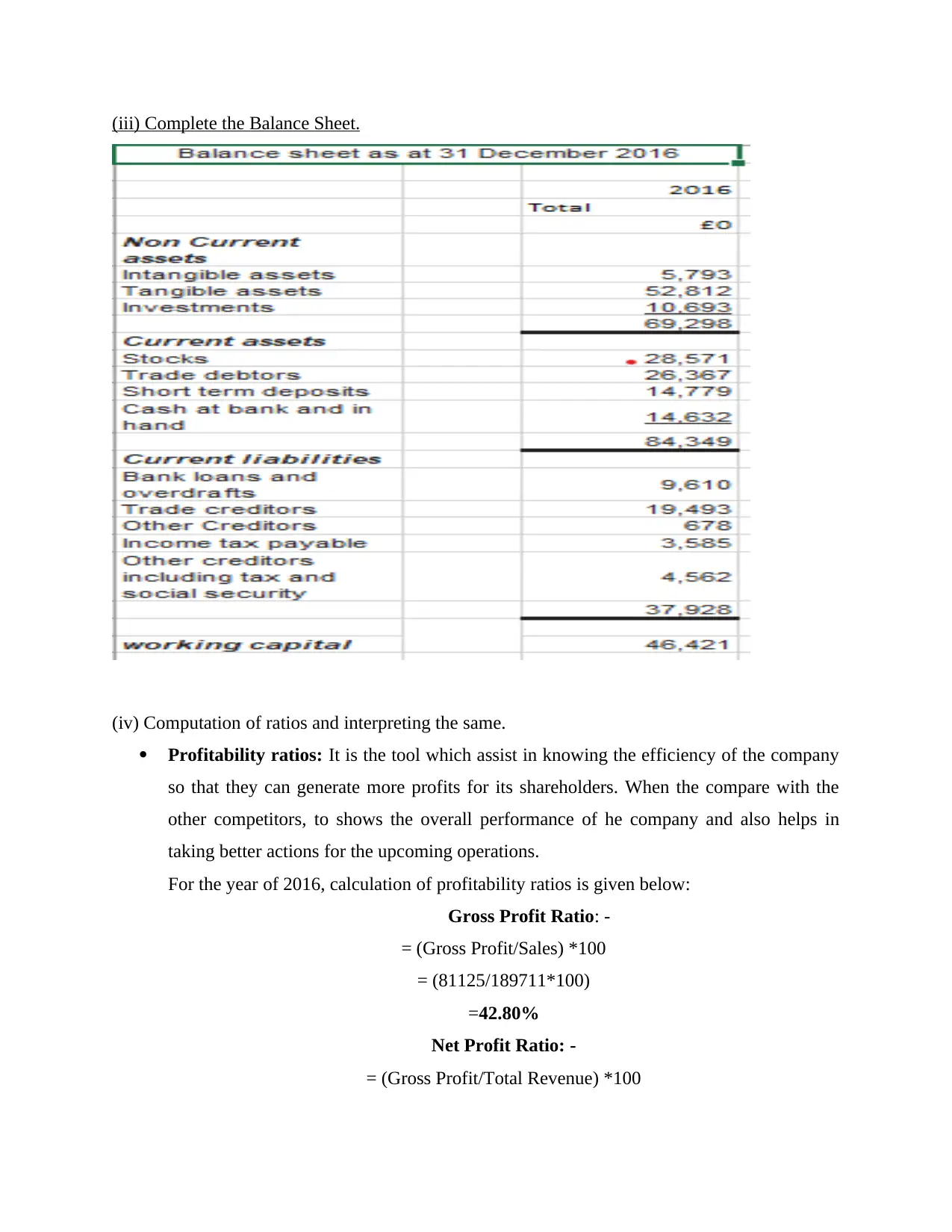
(iii) Complete the Balance Sheet.
(iv) Computation of ratios and interpreting the same.
Profitability ratios: It is the tool which assist in knowing the efficiency of the company
so that they can generate more profits for its shareholders. When the compare with the
other competitors, to shows the overall performance of he company and also helps in
taking better actions for the upcoming operations.
For the year of 2016, calculation of profitability ratios is given below:
Gross Profit Ratio: -
= (Gross Profit/Sales) *100
= (81125/189711*100)
=42.80%
Net Profit Ratio: -
= (Gross Profit/Total Revenue) *100
(iv) Computation of ratios and interpreting the same.
Profitability ratios: It is the tool which assist in knowing the efficiency of the company
so that they can generate more profits for its shareholders. When the compare with the
other competitors, to shows the overall performance of he company and also helps in
taking better actions for the upcoming operations.
For the year of 2016, calculation of profitability ratios is given below:
Gross Profit Ratio: -
= (Gross Profit/Sales) *100
= (81125/189711*100)
=42.80%
Net Profit Ratio: -
= (Gross Profit/Total Revenue) *100
Paraphrase This Document
Need a fresh take? Get an instant paraphrase of this document with our AI Paraphraser
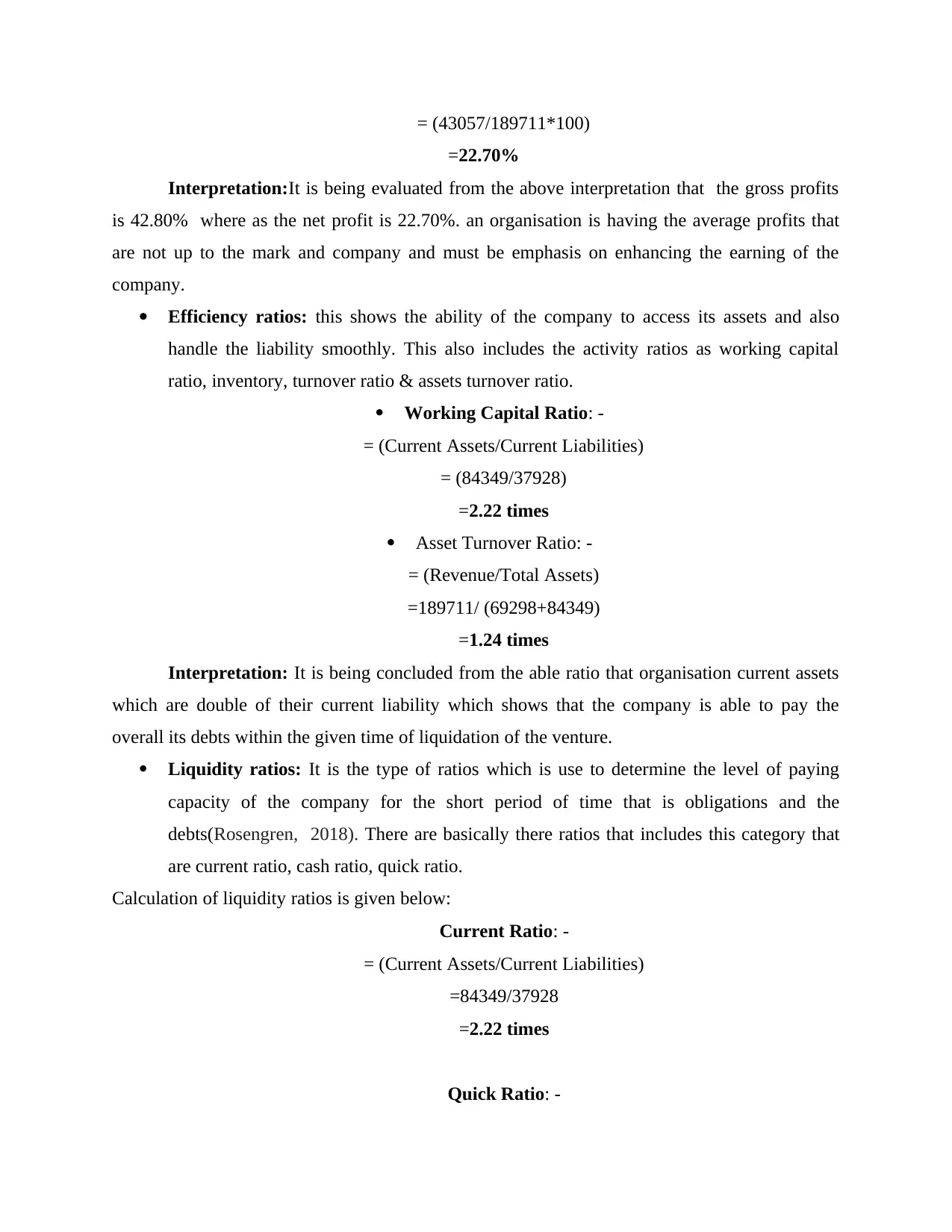
= (43057/189711*100)
=22.70%
Interpretation:It is being evaluated from the above interpretation that the gross profits
is 42.80% where as the net profit is 22.70%. an organisation is having the average profits that
are not up to the mark and company and must be emphasis on enhancing the earning of the
company.
Efficiency ratios: this shows the ability of the company to access its assets and also
handle the liability smoothly. This also includes the activity ratios as working capital
ratio, inventory, turnover ratio & assets turnover ratio.
Working Capital Ratio: -
= (Current Assets/Current Liabilities)
= (84349/37928)
=2.22 times
Asset Turnover Ratio: -
= (Revenue/Total Assets)
=189711/ (69298+84349)
=1.24 times
Interpretation: It is being concluded from the able ratio that organisation current assets
which are double of their current liability which shows that the company is able to pay the
overall its debts within the given time of liquidation of the venture.
Liquidity ratios: It is the type of ratios which is use to determine the level of paying
capacity of the company for the short period of time that is obligations and the
debts(Rosengren, 2018). There are basically there ratios that includes this category that
are current ratio, cash ratio, quick ratio.
Calculation of liquidity ratios is given below:
Current Ratio: -
= (Current Assets/Current Liabilities)
=84349/37928
=2.22 times
Quick Ratio: -
=22.70%
Interpretation:It is being evaluated from the above interpretation that the gross profits
is 42.80% where as the net profit is 22.70%. an organisation is having the average profits that
are not up to the mark and company and must be emphasis on enhancing the earning of the
company.
Efficiency ratios: this shows the ability of the company to access its assets and also
handle the liability smoothly. This also includes the activity ratios as working capital
ratio, inventory, turnover ratio & assets turnover ratio.
Working Capital Ratio: -
= (Current Assets/Current Liabilities)
= (84349/37928)
=2.22 times
Asset Turnover Ratio: -
= (Revenue/Total Assets)
=189711/ (69298+84349)
=1.24 times
Interpretation: It is being concluded from the able ratio that organisation current assets
which are double of their current liability which shows that the company is able to pay the
overall its debts within the given time of liquidation of the venture.
Liquidity ratios: It is the type of ratios which is use to determine the level of paying
capacity of the company for the short period of time that is obligations and the
debts(Rosengren, 2018). There are basically there ratios that includes this category that
are current ratio, cash ratio, quick ratio.
Calculation of liquidity ratios is given below:
Current Ratio: -
= (Current Assets/Current Liabilities)
=84349/37928
=2.22 times
Quick Ratio: -
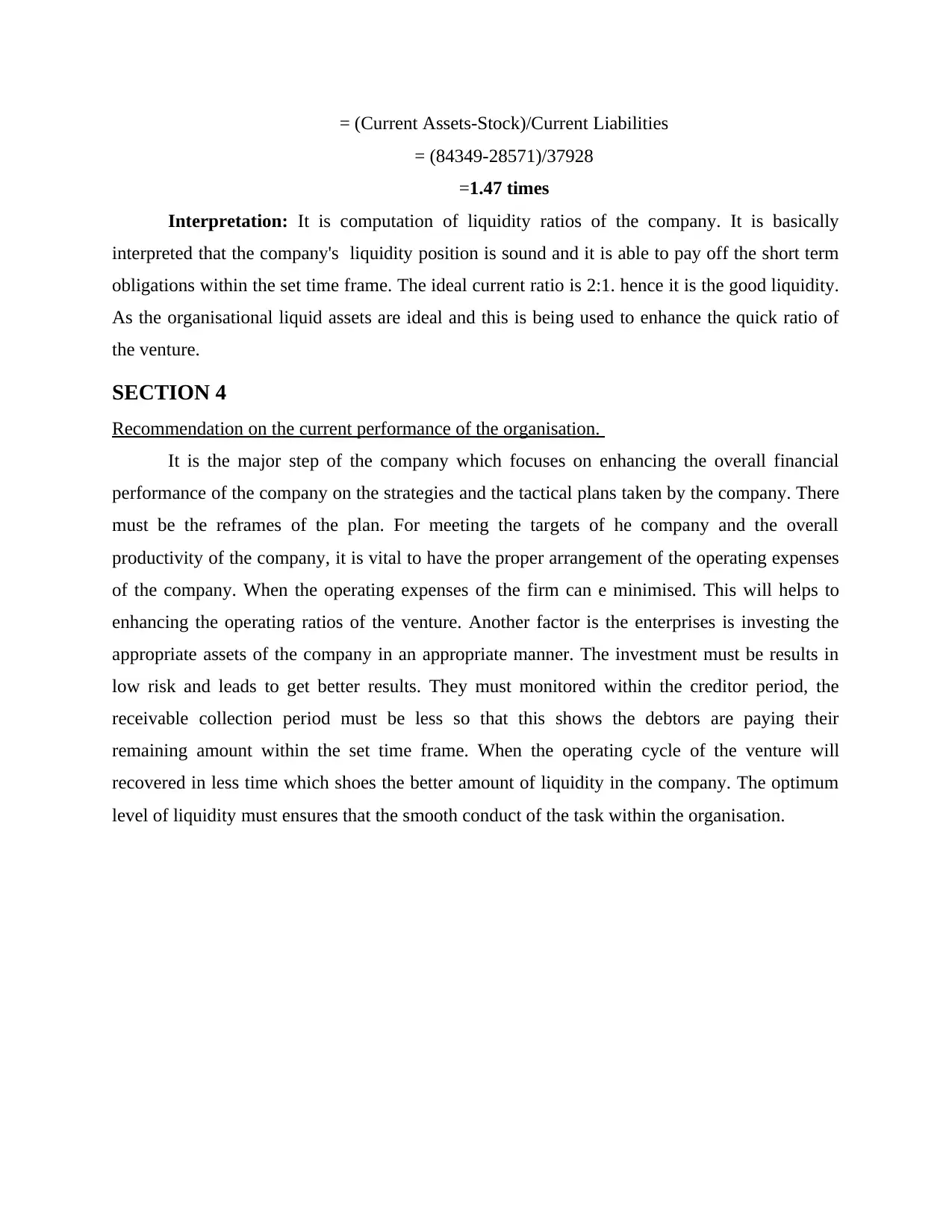
= (Current Assets-Stock)/Current Liabilities
= (84349-28571)/37928
=1.47 times
Interpretation: It is computation of liquidity ratios of the company. It is basically
interpreted that the company's liquidity position is sound and it is able to pay off the short term
obligations within the set time frame. The ideal current ratio is 2:1. hence it is the good liquidity.
As the organisational liquid assets are ideal and this is being used to enhance the quick ratio of
the venture.
SECTION 4
Recommendation on the current performance of the organisation.
It is the major step of the company which focuses on enhancing the overall financial
performance of the company on the strategies and the tactical plans taken by the company. There
must be the reframes of the plan. For meeting the targets of he company and the overall
productivity of the company, it is vital to have the proper arrangement of the operating expenses
of the company. When the operating expenses of the firm can e minimised. This will helps to
enhancing the operating ratios of the venture. Another factor is the enterprises is investing the
appropriate assets of the company in an appropriate manner. The investment must be results in
low risk and leads to get better results. They must monitored within the creditor period, the
receivable collection period must be less so that this shows the debtors are paying their
remaining amount within the set time frame. When the operating cycle of the venture will
recovered in less time which shoes the better amount of liquidity in the company. The optimum
level of liquidity must ensures that the smooth conduct of the task within the organisation.
= (84349-28571)/37928
=1.47 times
Interpretation: It is computation of liquidity ratios of the company. It is basically
interpreted that the company's liquidity position is sound and it is able to pay off the short term
obligations within the set time frame. The ideal current ratio is 2:1. hence it is the good liquidity.
As the organisational liquid assets are ideal and this is being used to enhance the quick ratio of
the venture.
SECTION 4
Recommendation on the current performance of the organisation.
It is the major step of the company which focuses on enhancing the overall financial
performance of the company on the strategies and the tactical plans taken by the company. There
must be the reframes of the plan. For meeting the targets of he company and the overall
productivity of the company, it is vital to have the proper arrangement of the operating expenses
of the company. When the operating expenses of the firm can e minimised. This will helps to
enhancing the operating ratios of the venture. Another factor is the enterprises is investing the
appropriate assets of the company in an appropriate manner. The investment must be results in
low risk and leads to get better results. They must monitored within the creditor period, the
receivable collection period must be less so that this shows the debtors are paying their
remaining amount within the set time frame. When the operating cycle of the venture will
recovered in less time which shoes the better amount of liquidity in the company. The optimum
level of liquidity must ensures that the smooth conduct of the task within the organisation.
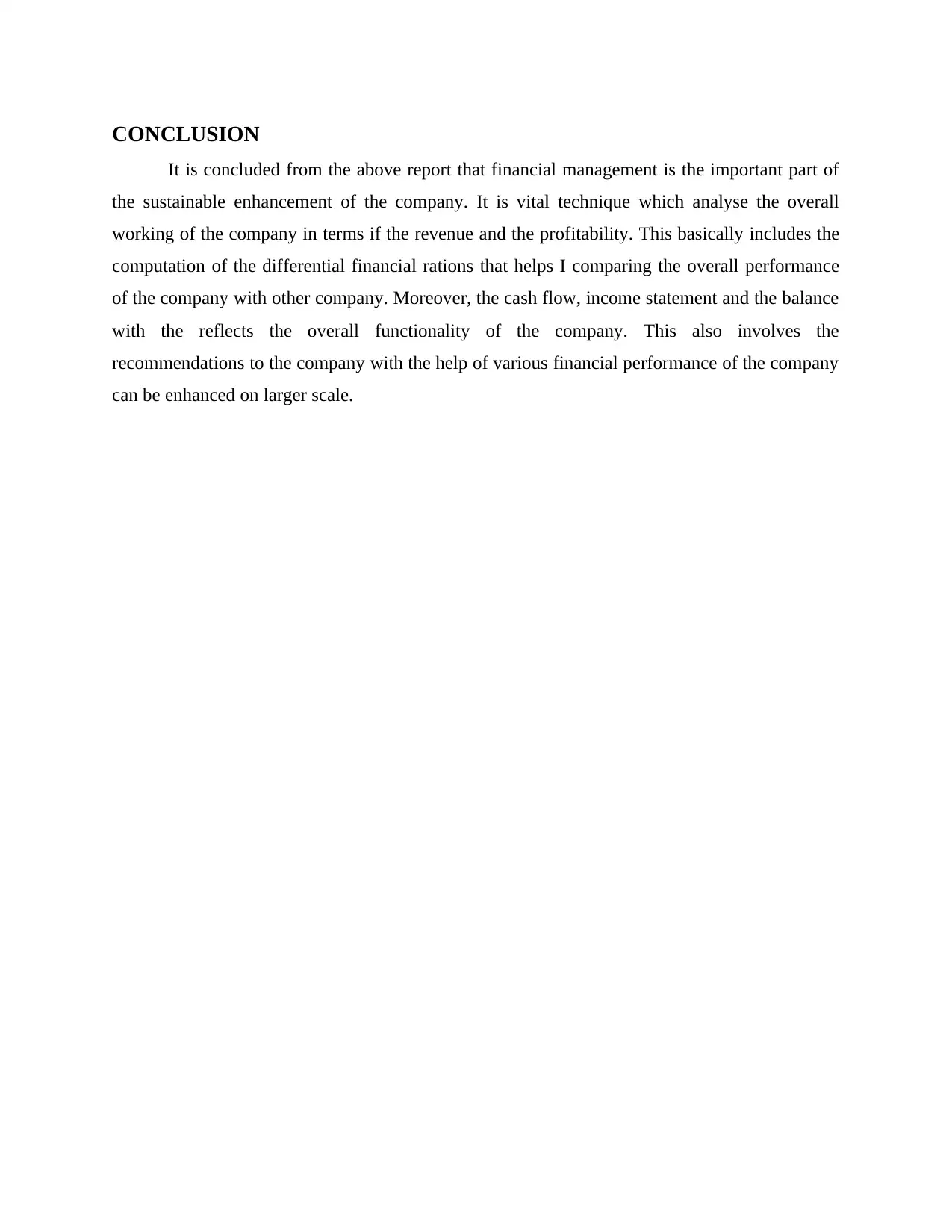
CONCLUSION
It is concluded from the above report that financial management is the important part of
the sustainable enhancement of the company. It is vital technique which analyse the overall
working of the company in terms if the revenue and the profitability. This basically includes the
computation of the differential financial rations that helps I comparing the overall performance
of the company with other company. Moreover, the cash flow, income statement and the balance
with the reflects the overall functionality of the company. This also involves the
recommendations to the company with the help of various financial performance of the company
can be enhanced on larger scale.
It is concluded from the above report that financial management is the important part of
the sustainable enhancement of the company. It is vital technique which analyse the overall
working of the company in terms if the revenue and the profitability. This basically includes the
computation of the differential financial rations that helps I comparing the overall performance
of the company with other company. Moreover, the cash flow, income statement and the balance
with the reflects the overall functionality of the company. This also involves the
recommendations to the company with the help of various financial performance of the company
can be enhanced on larger scale.
Secure Best Marks with AI Grader
Need help grading? Try our AI Grader for instant feedback on your assignments.
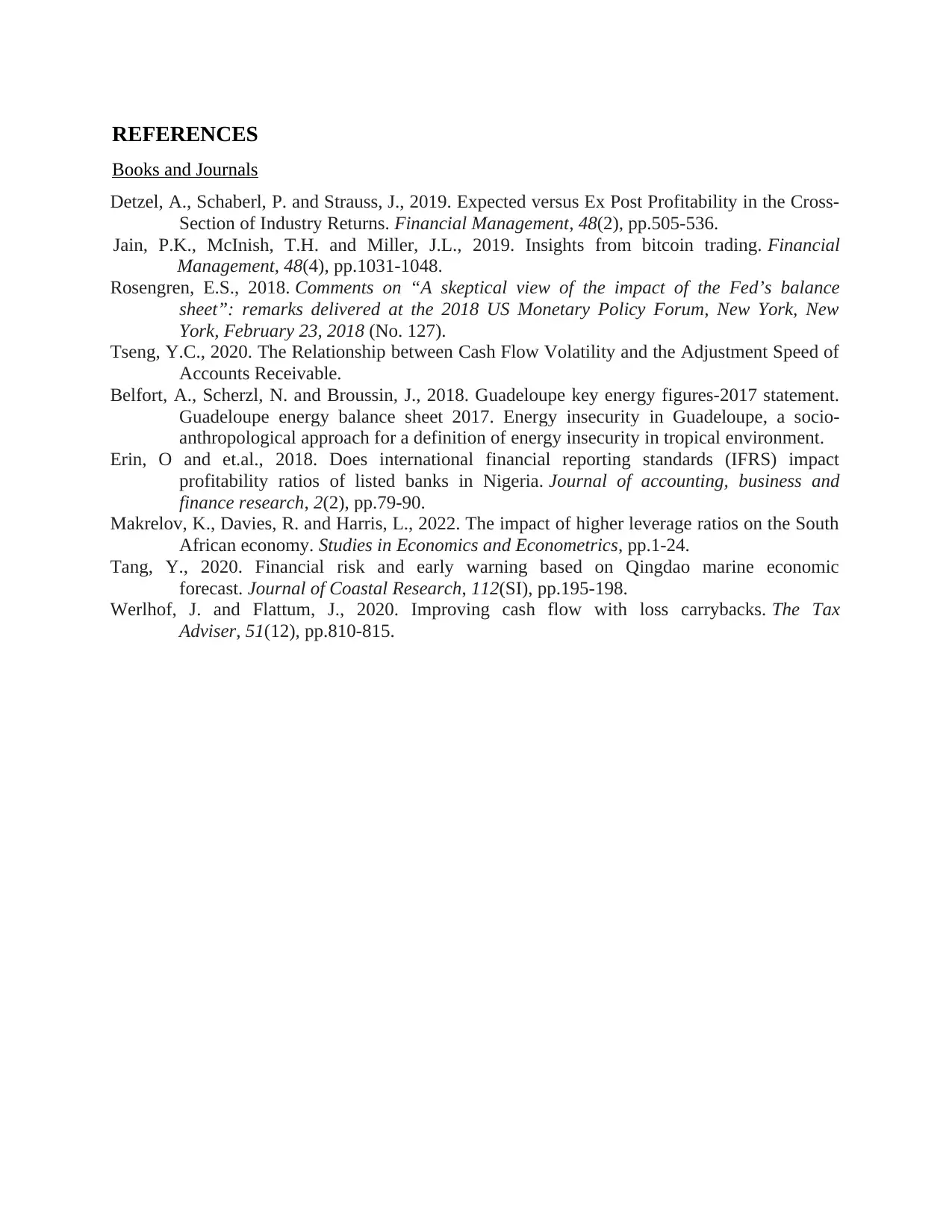
REFERENCES
Books and Journals
Detzel, A., Schaberl, P. and Strauss, J., 2019. Expected versus Ex Post Profitability in the Cross‐
Section of Industry Returns. Financial Management, 48(2), pp.505-536.
Jain, P.K., McInish, T.H. and Miller, J.L., 2019. Insights from bitcoin trading. Financial
Management, 48(4), pp.1031-1048.
Rosengren, E.S., 2018. Comments on “A skeptical view of the impact of the Fed’s balance
sheet”: remarks delivered at the 2018 US Monetary Policy Forum, New York, New
York, February 23, 2018 (No. 127).
Tseng, Y.C., 2020. The Relationship between Cash Flow Volatility and the Adjustment Speed of
Accounts Receivable.
Belfort, A., Scherzl, N. and Broussin, J., 2018. Guadeloupe key energy figures-2017 statement.
Guadeloupe energy balance sheet 2017. Energy insecurity in Guadeloupe, a socio-
anthropological approach for a definition of energy insecurity in tropical environment.
Erin, O and et.al., 2018. Does international financial reporting standards (IFRS) impact
profitability ratios of listed banks in Nigeria. Journal of accounting, business and
finance research, 2(2), pp.79-90.
Makrelov, K., Davies, R. and Harris, L., 2022. The impact of higher leverage ratios on the South
African economy. Studies in Economics and Econometrics, pp.1-24.
Tang, Y., 2020. Financial risk and early warning based on Qingdao marine economic
forecast. Journal of Coastal Research, 112(SI), pp.195-198.
Werlhof, J. and Flattum, J., 2020. Improving cash flow with loss carrybacks. The Tax
Adviser, 51(12), pp.810-815.
Books and Journals
Detzel, A., Schaberl, P. and Strauss, J., 2019. Expected versus Ex Post Profitability in the Cross‐
Section of Industry Returns. Financial Management, 48(2), pp.505-536.
Jain, P.K., McInish, T.H. and Miller, J.L., 2019. Insights from bitcoin trading. Financial
Management, 48(4), pp.1031-1048.
Rosengren, E.S., 2018. Comments on “A skeptical view of the impact of the Fed’s balance
sheet”: remarks delivered at the 2018 US Monetary Policy Forum, New York, New
York, February 23, 2018 (No. 127).
Tseng, Y.C., 2020. The Relationship between Cash Flow Volatility and the Adjustment Speed of
Accounts Receivable.
Belfort, A., Scherzl, N. and Broussin, J., 2018. Guadeloupe key energy figures-2017 statement.
Guadeloupe energy balance sheet 2017. Energy insecurity in Guadeloupe, a socio-
anthropological approach for a definition of energy insecurity in tropical environment.
Erin, O and et.al., 2018. Does international financial reporting standards (IFRS) impact
profitability ratios of listed banks in Nigeria. Journal of accounting, business and
finance research, 2(2), pp.79-90.
Makrelov, K., Davies, R. and Harris, L., 2022. The impact of higher leverage ratios on the South
African economy. Studies in Economics and Econometrics, pp.1-24.
Tang, Y., 2020. Financial risk and early warning based on Qingdao marine economic
forecast. Journal of Coastal Research, 112(SI), pp.195-198.
Werlhof, J. and Flattum, J., 2020. Improving cash flow with loss carrybacks. The Tax
Adviser, 51(12), pp.810-815.
1 out of 11
Related Documents
Your All-in-One AI-Powered Toolkit for Academic Success.
+13062052269
info@desklib.com
Available 24*7 on WhatsApp / Email
![[object Object]](/_next/static/media/star-bottom.7253800d.svg)
Unlock your academic potential
© 2024 | Zucol Services PVT LTD | All rights reserved.



